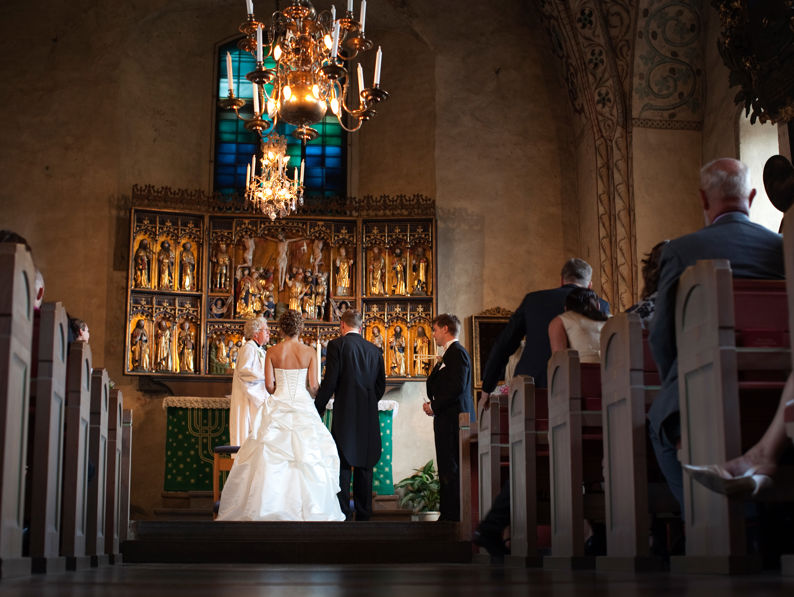British wedding traditions — where did they come from?
From wedding confetti to something blue, there's more to British wedding traditions than superstitions and a touch of good luck. There are plenty of timeless traditions that couples in the UK embrace on their big day. And many of these customs are well-known across the Western world, too. But where do these time-honoured wedding traditions come from? We've compiled a list of popular wedding traditions in the UK and the stories behind them. So, let’s start by looking at some of the common customs and rituals you may be familiar with.

Wedding cake
A popular tradition that couples across the UK embrace on their big day is the wedding cake. Most wedding day feasts comprise of the newlyweds’ cutting of the cake before guests can indulge in a slice.
The wedding cake custom goes back as early as the 16th century when the bride and groom kissed over a stack of buns as a sign of good luck for the marriage to come. The tradition later evolved into the bride’s pie, a pie filled with sweet bread or a mince pie, shared among guests. There are some accounts that it was tradition for relatives to leave pies under the bride’s pillow. By the 19th century, what we now refer to as a wedding cake became the more popular choice for wedding ceremonies.

Wedding rings
Married couples in the UK wear wedding rings to symbolise their commitment to one another. This tradition goes back to the first wedding rings worn in Ancient Egypt. They were made from braided reed or hemp and worn on the fourth finger of their left hand, where they believed their vein of love ran directly to their heart. Similar to today’s custom, Ancient Egyptians wore rings as a sign of commitment.
Metal wedding bands also have a long history dating back to Ancient Rome and Greece. Before iron became widespread, married people wore a ring band commonly fashioned of leather or bone. The wealthy often preferred gold and silver bands, which has become the common preference for couples today.
White dress
Walking down the aisle in white is an iconic custom in Britain. And, while the white wedding dress is a classic wedding day custom in many countries around the world, the tradition is somewhat a modern-day trend, dating back to 19th-century England. In fact, the white wedding gown only became fashionable among couples in the UK after Queen Victoria's wedding to Prince Albert in 1840 when she wore an ivory-white dress. Previously, couples in Britain donned their best garments, regardless of colour, for their wedding ceremony.
Even with bridal suits, jumpsuits and separates growing in popularity, white (and its various shades) remains the most popular colour choice for brides.
Confetti
Confetti is commonly thrown at traditional British weddings to celebrate newlyweds. This custom stems from Ancient Rome when wedding guests threw rice at the newly married couple to bring them wealth and fertility. But, nowadays, couples opt for confetti in favour of rice.
Giving away the bride
Historically, traditional wedding etiquette saw a father ‘giving away the bride’ at the wedding ceremony. This tradition dates back to a time when a bride’s father would give her away in exchange for a dowry or other sort of payment. Today, some couples opt to have their parents join them on the walk down the aisle, while others skip this ritual altogether.
There are many more wedding traditions in Great Britain, some fading in popularity, while others have long-forgotten origins.
Bride’s parents footing the bill
According to wedding tradition, it was custom for the bride’s parents to host and cover the costs of the ceremony, while the groom’s parents covered the honeymoon costs.
Naturally, as with many traditions, this custom is becoming less widespread today. Some parents may offer to pay for their children’s weddings. Or there may be a three-way split between both sides of the family and the couple, while some couples foot the entire wedding bill themselves. Every union is different.

A sixpence in the bride’s shoe
‘Something old, something new, something borrowed, something blue, and a sixpence in her shoe.’ While the first four lines of this traditional rhyme are well-known throughout the UK, the original version is not. Dating back to the Victorian era, the final line ‘a sixpence in her shoe’ refers to the custom of the bride’s father placing a sixpence in the heel of her shoe to symbolise good fortune to come.
Steer clear from mirrors
Some English wedding traditions are founded on superstition, and the exact origins of these customs often remain unknown. For example, some couples in the UK believe looking in the mirror before they walk down the aisle on their wedding day will bring bad luck to the marriage. So, to avoid any misfortune, only take a peek in the mirror after the vows.
Welsh wedding traditions
There are many Welsh wedding traditions distinctive to the region. For example, some brides will carry a bouquet containing myrtle leaves to symbolise love in life. The bride gives a cutting to her bridesmaids, and it’s thought if the plant blooms, the bridesmaid would soon find love and get married.
Bridenapping is another popular tradition. Before the wedding ceremony, the bride's relatives would traditionally ‘kidnap’ her. The groom and his family would then 'rescue' her, and whoever freed the bride would marry within a year.
Scottish wedding traditions
Some couples who tie the knot in Scotland embrace several unique customs on their wedding day. The Scottish Quaich (also known as the Loving Cup) is a two-handled silver bowl filled with whisky, most commonly by the bride. It’s then passed around the wedding guests to sip in celebration of the newly married couple.
Another custom observed at a traditional Scottish wedding is the wedding scramble. This unique Scottish tradition sees the bride’s father drop a handful of coins for children to collect as the bride steps into her car. Many people believe this custom brings good fortune and wealth to the happy couple.
Irish wedding traditions
Many couples in Ireland incorporate wedding traditions into their big day that are exclusive to their region. One popular tradition is the lace handkerchief that the bride carries on her wedding day. The happy couple will often embroider the lace using their names or initials. Later, the bride will use the handkerchief to make a bonnet for her first child’s christening.
Some couples will also celebrate their nuptials by tying their hands together with rope, lace or ribbon. This tradition dates back centuries when a person of high importance in the community oversaw the ritual, such as a druid. The tying of hands represents the newlyweds’ union, which will grow stronger even in the face of adversity.

Planning your wedding
With so much thought and preparation going into your big day, it's easy to overlook the simple things that may make your ceremony truly special.
It’s important to remember that every wedding is different. As time moves on, many wedding traditions are no longer in fashion and couples are choosing to turn their back on some of these old-age wedding traditions that don’t work for them. Your wedding is your day and you should tailor it to suit you whether that’s incorporating long-standing customs, bending them to create a unique ceremony, or maybe creating a new tradition to add another dimension to your wedding day.
Article Author
For more articles from Paul, explore their author profile

Paul Went – Managing Director, Consumer Banking
Related Articles

The ultimate guide to financing your wedding
Getting married can be a costly affair when you start to add everything up. Our ultimate guide is the perfect place to find out not just the different types of costs you might be confronted with – but also the different options you could explore to help you pay for the big day.

The ultimate guide to personal loans
When it comes to personal loans, there’s plenty of jargon to get your head around. Here you’ll find a simple breakdown of the basics of personal loans – from common uses and benefits to the ins-and-outs of APRs and credit checks.

How long does it take to get a loan approved?
If you applied for a personal loan before, the process may have been confusing. In this guide, we’ll take you through each step of a typical loan application, so you know exactly what to expect when you apply.